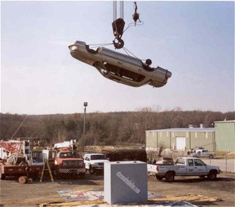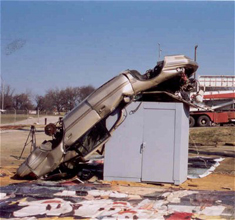Shelter from the Storm
Air Date: Week of June 16, 2006

At a Tulsa Home and Garden Show Demonstration, a 1989 Lincoln Continental is suspended 40 feet above a storm-safe shelter. (Photo courtesy of: Storm Safe Rooms)
Brad Webb of Tulsa, Oklahoma, offers shelter from the storm with his industry-tested product: The Storm Safe Room.
Transcript
CURWOOD: Well, the tornado and hurricane season is here. It’s the busy time of year for Brad Webb. His Tulsa, Oklahoma, company, Storm Safe Rooms, produces steel-reinforced shelters from violent windstorms. Mr. Webb, hello.
WEBB: How’re you doing?
CURWOOD: Now can you just briefly describe what one of your safe rooms looks like?
WEBB: Well our best-selling safe room is a four-foot by six-foot box, basically, six-foot two-inch tall headroom, got a little folding two-person bench in the unit for people to sit on. About 90 percent of them slide into the garage and bolt down. Some of our safe rooms, of course, you can put electrical switches in ‘em and light switches and resets. You can insulate ‘em, screw sheet rock to ‘em, trim ‘em, paint ‘em, make them look like the rest of the house, and you can’t even tell it’s a Safe room.
CURWOOD: So how do you know that they’re safe, that they can survive a Category 5 hurricane or a tornado?

At a Tulsa Home and Garden Show Demonstration, a 1989 Lincoln Continental is suspended 40 feet above a storm-safe shelter. (Photo courtesy of: Storm Safe Rooms)
To give you an idea of just how tough that test is, here a few years back during the Tulsa home and garden show we dropped a 1989 Lincoln Continental 40 feet using a hundred ton crane doing a demonstration for the home and garden show.
CURWOOD: Yeah.
WEBB: We dropped it on to this safe room two times and just demolished the car, and we didn’t even make a dent in this safe room.
CURWOOD: Now, are these designed to survive floods and earthquakes as well?

Lincoln Continental and storm-safe room, post-demonstration. (Photo courtesy of: Storm Safe Rooms)
CURWOOD: I got an ethical question for you. Somebody has a Storm Safe Room, it’s got room for, let’s say, six people, and there are ten people there. Maybe the folks next door, maybe the kids from down the block are there. What are they gonna do?
WEBB: Well, five square feet per person is the standard. But I’ve heard, you know, I’ve heard stories at the home and garden shows about a tornado came through the area and we’ve got a six by eight shelter, it holds, you know, nine or 10 people, and we had 16 people in there, you know, and two dogs! So, I mean, I’m not sure if I was grandma and grandpa and the kids were all visiting and tornado’s coming through we wouldn’t, you know, leave them out in the garage.
CURWOOD: Is it a good idea to let your neighbors know that you have one of these things?
WEBB: Well, you know, most people are pretty private about ‘em, really. Sometimes when I was first starting this business I had little signs made that show my name and phone number in the front yard while we’re putting one in, and about nine out of 10 customers didn’t really want me to even display a sign. So it seems to be a pretty private thing.
CURWOOD: They don’t want the neighbors from down the street to come running up and bang on their door at the last minute, huh?
WEBB: Yeah. And some neighbors, you know, are more worried about seeing a little bit of wind and they’re calling ‘em and running over to the house. One guy might think it’s no big deal, wish they weren’t coming over every time the wind blows, you know.
CURWOOD: What do you suppose people think they’re going to do otherwise?
WEBB: I think it’s out of sight out of mind business. Until you really have one of them big F5 bad boys, or an F4, or even an F2 bear down right directly on you, I mean, it’s, it can be pretty frightening. Until then, you know, a lot of folks just think “It’s never going to happen to me.” You know, kind of like “I’m never gonna have a” – one guy explained it to me when I put a shelter in, “I hope I never have to use it, and I hope I never have a head-on collision in my car, but I’m gonna keep wearing my seatbelt.
CURWOOD: Well thank you so much, sir, for filling us in on the Storm Safe Rooms.
WEBB: You’re welcome. I appreciate it.
CURWOOD: Brad Webb is owner of Storm Safe Rooms in Tulsa, Oklahoma.
Links
Texas Tech University: Wind Science and Engineering Research Center
Living on Earth wants to hear from you!
Living on Earth
62 Calef Highway, Suite 212
Lee, NH 03861
Telephone: 617-287-4121
E-mail: comments@loe.org
Newsletter [Click here]
Donate to Living on Earth!
Living on Earth is an independent media program and relies entirely on contributions from listeners and institutions supporting public service. Please donate now to preserve an independent environmental voice.
NewsletterLiving on Earth offers a weekly delivery of the show's rundown to your mailbox. Sign up for our newsletter today!
 Sailors For The Sea: Be the change you want to sea.
Sailors For The Sea: Be the change you want to sea.
 The Grantham Foundation for the Protection of the Environment: Committed to protecting and improving the health of the global environment.
The Grantham Foundation for the Protection of the Environment: Committed to protecting and improving the health of the global environment.
 Contribute to Living on Earth and receive, as our gift to you, an archival print of one of Mark Seth Lender's extraordinary wildlife photographs. Follow the link to see Mark's current collection of photographs.
Contribute to Living on Earth and receive, as our gift to you, an archival print of one of Mark Seth Lender's extraordinary wildlife photographs. Follow the link to see Mark's current collection of photographs.
 Buy a signed copy of Mark Seth Lender's book Smeagull the Seagull & support Living on Earth
Buy a signed copy of Mark Seth Lender's book Smeagull the Seagull & support Living on Earth

